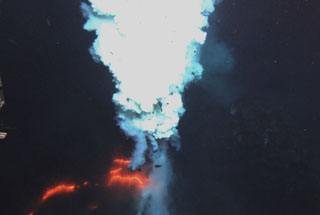Report on West Mata (Tonga) — 13 May-19 May 2009
Smithsonian Institution / US Geological Survey
Weekly Volcanic Activity Report, 13 May-19 May 2009
Managing Editor: Sally Sennert.
Please cite this report as:
Global Volcanism Program, 2009. Report on West Mata (Tonga) (Sennert, S, ed.). Weekly Volcanic Activity Report, 13 May-19 May 2009. Smithsonian Institution and US Geological Survey.
West Mata
Tonga
15.1°S, 173.75°W; summit elev. -1174 m
All times are local (unless otherwise noted)
In early May, scientists from an NSF (RIDGE and MARGINS Programs) and NOAA (Ocean Exploration Program) sponsored cruise on the University of Washington vessel, the R/V Thompson, traveled to the Lau-Tonga region. This rapid-response expedition was undertaken after strong indications of submarine eruptive activity had been detected during a November 2008 NOAA Vents Program expedition. On 6 and 7 May, team members used the Jason 2 ROV to observe eruptions from two vents of West Mata, a small submarine volcanic cone in the northeast Lau Basin, about 200 km SW of Samoa. Explosive activity occurred from one end of a 5-m-long fissure at Hades vent, at a depth of 1,208 m, while pillow lavas erupted from the other end of the fissure. Glowing bubbles up to a meter in diameter also issued from the fissure. The Prometheus vent, a cinder cone located near the summit and about 100 m N of Hades, erupted explosively with nearly continuous lava fountains that ejected tephra into the water. Both vents were often obscured by sulfur gas emissions, but incandescence was visible for minutes at a time.
Geological Summary. West Mata, a submarine volcano rising to within 1,174 m of the ocean surface, is located in the northeastern Lau Basin at the northern end of the Tofua arc, about 200 km SW of Samoa and north of the Curacoa submarine volcano. Discovered during a November 2008 NOAA Vents Program expedition it was found to be producing submarine hydrothermal plumes consistent with recent lava effusion. A return visit in May 2009 documented explosive and effusive activity from two closely spaced vents, one at the summit, and the other on the SW rift zone.
Source: NOAA Vents Program

